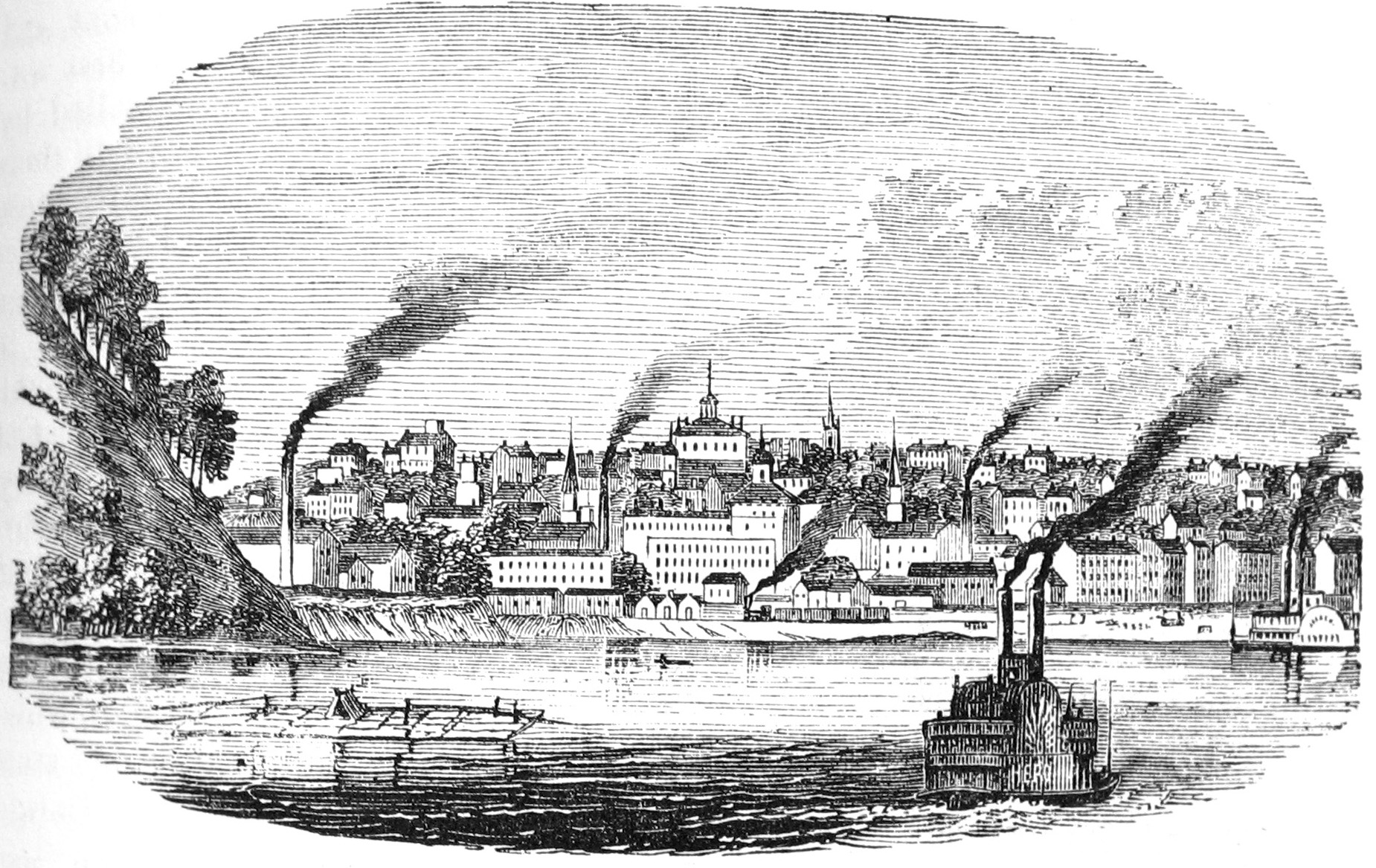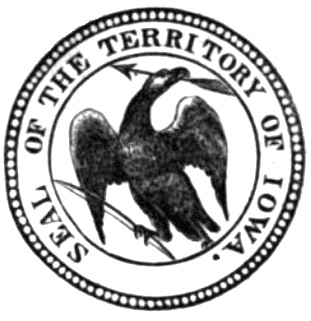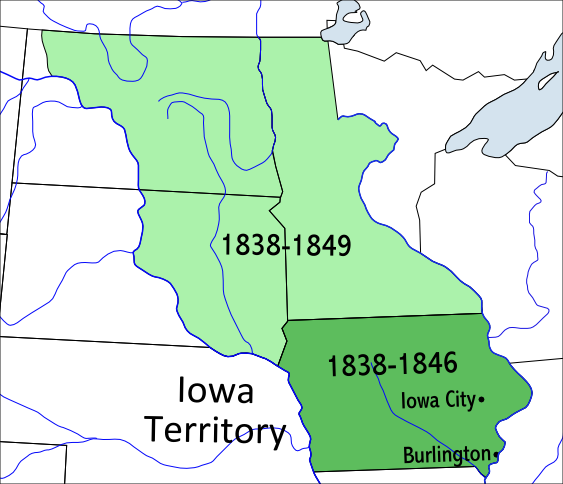|
David Rorer
David Rorer (May 12, 1806 – July 7, 1884) was a lawyer, judge, sometime politician, author and anti-slavery advocate from Burlington, Iowa, who played a prominent role in the early history of Burlington and in Iowa legal history, and is credited with bestowing the nickname of " Hawkeyes" upon Iowans. Early life Rorer was born May 12, 1806, son of Abraham Rorer and Nancy (Cook) Rorer, on their farm in Pittsylvania County, Virginia. He attended the local schools, and eventually read law under local attorneys Nathaniel H. Claiborne and Henry Calaway for two years. In 1826 he was admitted to the bar and moved to Little Rock, Arkansas Territory, where he took up practice. He owned the ferry in Little Rock. A 1908 history states, "he kept a good house of entertainment" on the city's north side, and entertained Territorial Governor John Pope. By the census of 1830, he owned seven slaves, which marked him among the elite of the region. In 1831, he was elected county judge of Pulas ... [...More Info...] [...Related Items...] OR: [Wikipedia] [Google] [Baidu] |
Burlington, Iowa
Burlington is a city in, and the county seat of, Des Moines County, Iowa, United States. The population was 23,982 in the 2020 census, a decline from the 26,839 population in 2000. Burlington is the center of a micropolitan area, which includes West Burlington and Middletown, Iowa, and Gulfport, Illinois. Burlington is the home of Snake Alley, the most crooked street. History Prior to European settlement, the area was neutral territory for the Sac and Fox Native American tribes, who called it Shoquoquon (''Shok-ko-kon''), meaning Flint Hills. In 1803, President Thomas Jefferson organized two parties of explorers to map the Louisiana Purchase. The Lewis and Clark Expedition followed the Missouri River, while Lt. Zebulon Pike followed the Mississippi River. In 1805, Pike landed at the bluffs below Burlington and raised the United States Flag for the first time on what would become Iowa soil and recommended construction of a fort. The recommendation went unheeded. The Am ... [...More Info...] [...Related Items...] OR: [Wikipedia] [Google] [Baidu] |
Wisconsin Territory
The Territory of Wisconsin was an organized incorporated territory of the United States that existed from July 3, 1836, until May 29, 1848, when an eastern portion of the territory was admitted to the Union as the State of Wisconsin. Belmont was initially chosen as the capital of the territory. In 1837, the territorial legislature met in Burlington, just north of the Skunk River on the Mississippi, which became part of the Iowa Territory in 1838. In that year, 1838, the territorial capital of Wisconsin was moved to Madison. Territorial area The Wisconsin Territory initially included all of the present-day states of Wisconsin, Minnesota, and Iowa, and part of the Dakotas east of the Missouri River. Much of the territory had originally been part of the Northwest Territory, which was ceded by Britain in 1783. The portion in what is now Iowa and the Dakotas was originally part of the Louisiana Purchase and was split off from the Missouri Territory in 1821 and attached to the Michi ... [...More Info...] [...Related Items...] OR: [Wikipedia] [Google] [Baidu] |
Iowa City, Iowa
Iowa City, offically the City of Iowa City is a city in Johnson County, Iowa, United States. It is the home of the University of Iowa and county seat of Johnson County, at the center of the Iowa City Metropolitan Statistical Area. At the time of the 2020 census the population was 74,828, making it the state's fifth-largest city. The metropolitan area, which encompasses Johnson and Washington counties, has a population of over 171,000. The Iowa City Metropolitan Statistical Area (MSA) is also a part of a Combined Statistical Area (CSA) with the Cedar Rapids MSA. This CSA plus two additional counties are known as the Iowa City-Cedar Rapids region which collectively has a population of nearly 500,000. Iowa City was the second capital of the Iowa Territory and the first capital city of the State of Iowa. The Old Capitol building is a National Historic Landmark in the center of the University of Iowa campus. The University of Iowa Art Museum and Plum Grove, the home of the firs ... [...More Info...] [...Related Items...] OR: [Wikipedia] [Google] [Baidu] |
State Historical Society Of Iowa
The State Historical Society of Iowa (SHSI), a division of the Iowa Department of Cultural Affairs, serves as the official historical repository for the State of Iowa and also provides grants, public education, and outreach about Iowa history and archaeology. The SHSI maintains a museum, library, archives, and research center in Des Moines and a research library in Iowa City, as well as several historic sites in Iowa. It was founded in 1857 in Iowa City, where it was first affiliated with the University of Iowa. As the organization grew in size and collections, it became a separate state agency headquartered near the Iowa Capitol in Des Moines. SHSI publications The SHSI currently publishes the ''Annals of Iowa''. In the past it published the ''Iowa Heritage Illustrated'', ''Goldfinch'', the ''Iowa Journal of History and Politics'', and the ''Iowa Historical Record''. It also currently produces an e-newsletter, the ''Iowa Historian''. State and federal regulation The SHSI is ... [...More Info...] [...Related Items...] OR: [Wikipedia] [Google] [Baidu] |
Whig Party (United States)
The Whig Party was a political party in the United States during the middle of the 19th century. Alongside the slightly larger Democratic Party, it was one of the two major parties in the United States between the late 1830s and the early 1850s as part of the Second Party System. Four presidents were affiliated with the Whig Party for at least part of their terms. Other prominent members of the Whig Party include Henry Clay, Daniel Webster, Rufus Choate, William Seward, John J. Crittenden, and John Quincy Adams. The Whig base of support was centered among entrepreneurs, professionals, planters, social reformers, devout Protestants, and the emerging urban middle class. It had much less backing from poor farmers and unskilled workers. The party was critical of Manifest Destiny, territorial expansion into Texas and the Southwest, and the Mexican-American War. It disliked strong presidential power as exhibited by Jackson and Polk, and preferred Congressional dominance in lawma ... [...More Info...] [...Related Items...] OR: [Wikipedia] [Google] [Baidu] |
Peter H
Peter may refer to: People * List of people named Peter, a list of people and fictional characters with the given name * Peter (given name) ** Saint Peter (died 60s), apostle of Jesus, leader of the early Christian Church * Peter (surname), a surname (including a list of people with the name) Culture * Peter (actor) (born 1952), stage name Shinnosuke Ikehata, Japanese dancer and actor * Peter (album), ''Peter'' (album), a 1993 EP by Canadian band Eric's Trip * Peter (1934 film), ''Peter'' (1934 film), a 1934 film directed by Henry Koster *Peter (2021 film), ''Peter'' (2021 film), Marathi language film * Peter (Fringe episode), "Peter" (''Fringe'' episode), an episode of the television series ''Fringe'' * Peter (novel), ''Peter'' (novel), a 1908 book by Francis Hopkinson Smith * Peter (short story), "Peter" (short story), an 1892 short story by Willa Cather Animals * Peter, the Lord's cat, cat at Lord's Cricket Ground in London * Peter (chief mouser), Chief Mouser between 1929 a ... [...More Info...] [...Related Items...] OR: [Wikipedia] [Google] [Baidu] |
William W
William is a male given name of Germanic origin.Hanks, Hardcastle and Hodges, ''Oxford Dictionary of First Names'', Oxford University Press, 2nd edition, , p. 276. It became very popular in the English language after the Norman conquest of England in 1066,All Things William"Meaning & Origin of the Name"/ref> and remained so throughout the Middle Ages and into the modern era. It is sometimes abbreviated "Wm." Shortened familiar versions in English include Will, Wills, Willy, Willie, Bill, and Billy. A common Irish form is Liam. Scottish diminutives include Wull, Willie or Wullie (as in Oor Wullie or the play ''Douglas''). Female forms are Willa, Willemina, Wilma and Wilhelmina. Etymology William is related to the given name ''Wilhelm'' (cf. Proto-Germanic ᚹᛁᛚᛃᚨᚺᛖᛚᛗᚨᛉ, ''*Wiljahelmaz'' > German ''Wilhelm'' and Old Norse ᚢᛁᛚᛋᛅᚼᛅᛚᛘᛅᛋ, ''Vilhjálmr''). By regular sound changes, the native, inherited English form of the name should b ... [...More Info...] [...Related Items...] OR: [Wikipedia] [Google] [Baidu] |
26th United States Congress
The 26th United States Congress was a meeting of the legislative branch of the United States federal government, consisting of the United States Senate and the United States House of Representatives. It met in Washington, D.C. from March 4, 1839, to March 4, 1841, during the third and fourth years of Martin Van Buren's presidency. The apportionment of seats in the House of Representatives was based on the Fifth Census of the United States in 1830. Both chambers had a Democratic majority. Major events * 1839: The first state law permitting women to own property was passed in Jackson, Mississippi * January 19, 1840: Captain Charles Wilkes circumnavigated Antarctica, claiming what becomes known as Wilkes Land for the United States. * November 7, 1840: U.S. presidential election, 1840: William Henry Harrison defeated Martin Van Buren * February 18, 1841: The first ongoing filibuster in the United States Senate began and lasted until March 11 Major legislation * Party summary ... [...More Info...] [...Related Items...] OR: [Wikipedia] [Google] [Baidu] |
Non-voting Members Of The United States House Of Representatives
Non-voting members of the United States House of Representatives (called either delegates or resident commissioner, in the case of Puerto Rico) are representatives of their territory in the House of Representatives, who do not have a right to vote on proposed legislation in the full House but nevertheless have floor privileges and are able to participate in certain other House functions. Non-voting members may vote in a House committee of which they are a member and introduce legislation. There are currently six non-voting members: a delegate representing the District of Columbia, a resident commissioner representing Puerto Rico, as well as one delegate for each of the other four permanently inhabited U.S. territories: American Samoa, Guam, the Northern Mariana Islands and the U.S. Virgin Islands. A seventh delegate, representing the Cherokee Nation, has been formally proposed but not yet seated, while an eighth, representing the Choctaw Nation, is named in a treaty but has neit ... [...More Info...] [...Related Items...] OR: [Wikipedia] [Google] [Baidu] |
Iowa Territory
The Territory of Iowa was an organized incorporated territory of the United States that existed from July 4, 1838, until December 28, 1846, when the southeastern portion of the territory was admitted to the Union as the state of Iowa. The remainder of the territory would have no organized territorial government until the Minnesota Territory was organized on March 3, 1849. History Most of the area in the territory was originally part of the Louisiana Purchase and was a part of the Missouri Territory. When Missouri became a state in 1821, this area (along with the Dakotas) effectively became unorganized territory. The area was closed to white settlers until the 1830s, after the Black Hawk War ended. It was attached to the Michigan Territory on June 28, 1834. At an extra session of the Sixth Legislative Assembly of Michigan held in September, 1834, the Iowa District was divided into two counties by running a line due west from the lower end of Rock Island in the Mississippi Rive ... [...More Info...] [...Related Items...] OR: [Wikipedia] [Google] [Baidu] |
Iowa District
The Iowa District was a region of north-central North America west of the Mississippi River claimed by the United States. From June 28, 1834, to July 4, 1838, it was part of the Michigan Territory and, later, the Wisconsin Territory. It included not only the area which became the state of Iowa, but parts of what would become Minnesota, North Dakota and South Dakota. In September 1834, at an extra session of the Sixth Legislative Assembly of Michigan, the Iowa District was divided into two counties. A border was drawn due west from the lower end of Rock Island in the Mississippi River. The territory north of this line (which started just south of the present-day Davenport) was named Dubuque County, and all area to the south of the line was named Des Moines County. The Wisconsin Territory was trimmed back on July 4, 1838, and the entirety of the Iowa District became the new Iowa Territory The Territory of Iowa was an organized incorporated territory of the United States that ... [...More Info...] [...Related Items...] OR: [Wikipedia] [Google] [Baidu] |
Waterloo-Cedar Falls Courier
''The Waterloo-Cedar Falls Courier'' is a daily afternoon newspaper published by Lee Enterprises for people living in Waterloo and Cedar Falls, Iowa as well as northeast Iowa. The first issue of ''The Waterloo-Cedar Falls Courier'' was published on November 22, 1859, by WH Hartman and George Ingersoll. ''The Courier'' changed to a daily newspaper in 1890, publishing in the afternoon every day except Saturday. Howard Publications bought the ''Waterloo Courier'' and ''Cedar Falls Record'' in 1983. At that time, the ''Courier'' had been owned for 128 years by the same family, and had a daily circulation of around 55,000 in 1983. The circulation of ''The Record'' was about 4,000.(27 January 1983)The impending sale of the Waterloo Courier and the... ''UPI'' Lee Enterprises acquired the Howard chain in 2002.(13 February 2002)Lee Newspapers to buy Howard Publications ''The Baltimore Sun ''The Baltimore Sun'' is the largest general-circulation daily newspaper based in the U.S. ... [...More Info...] [...Related Items...] OR: [Wikipedia] [Google] [Baidu] |







